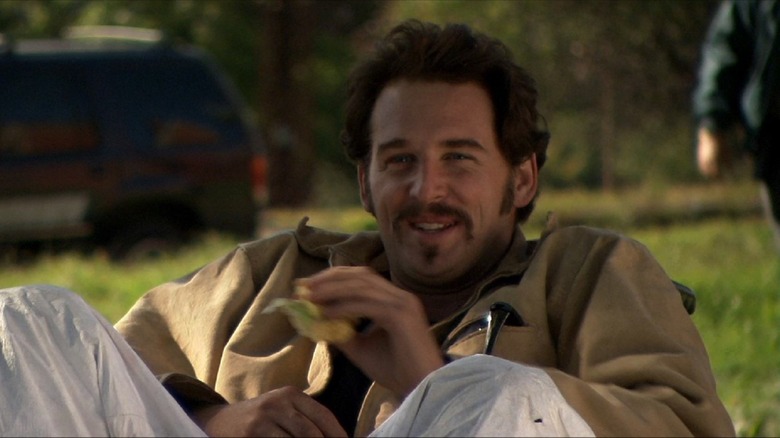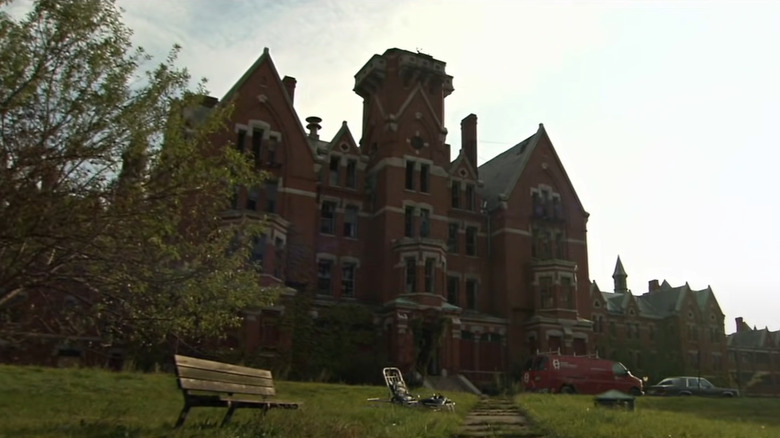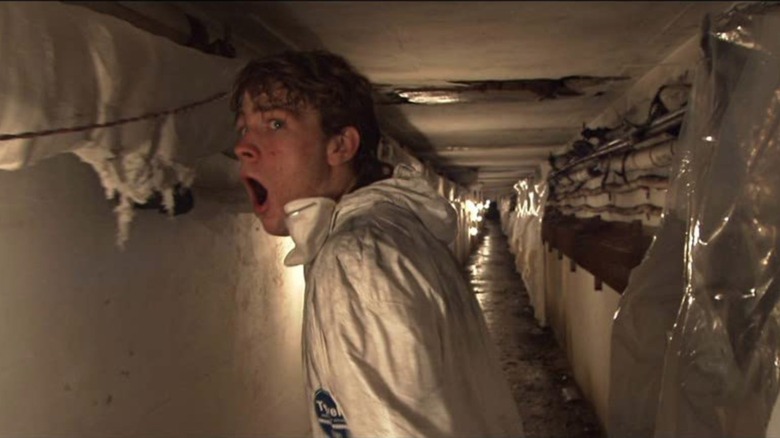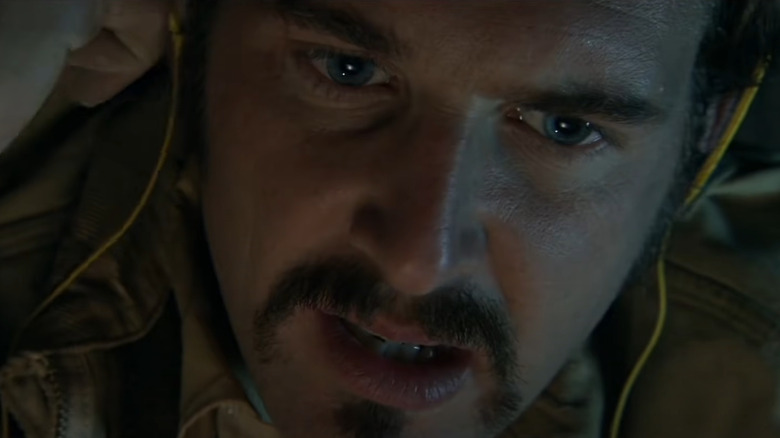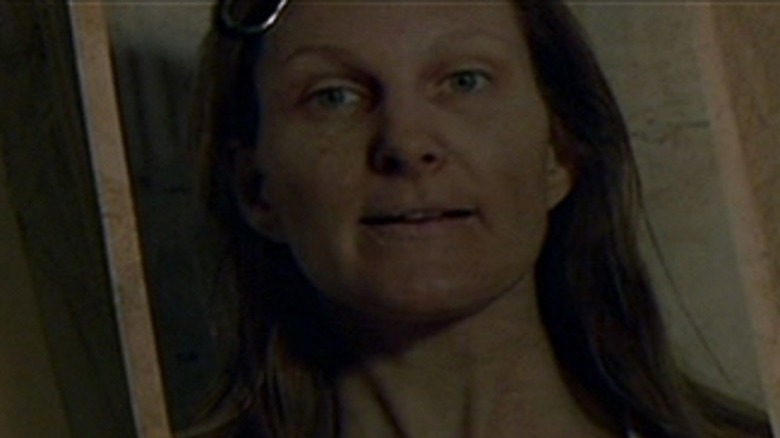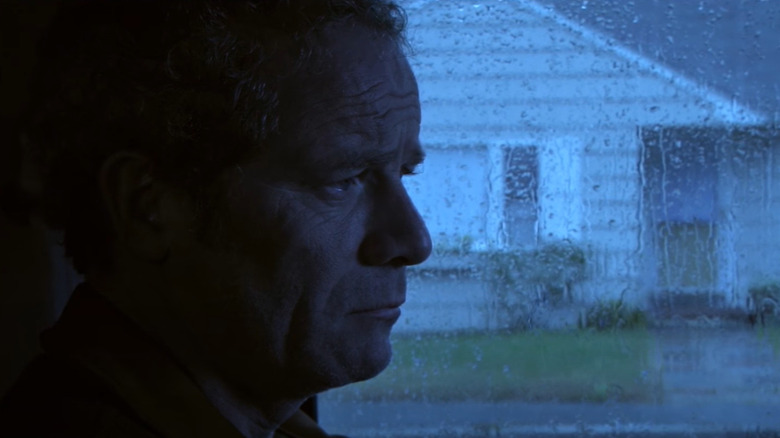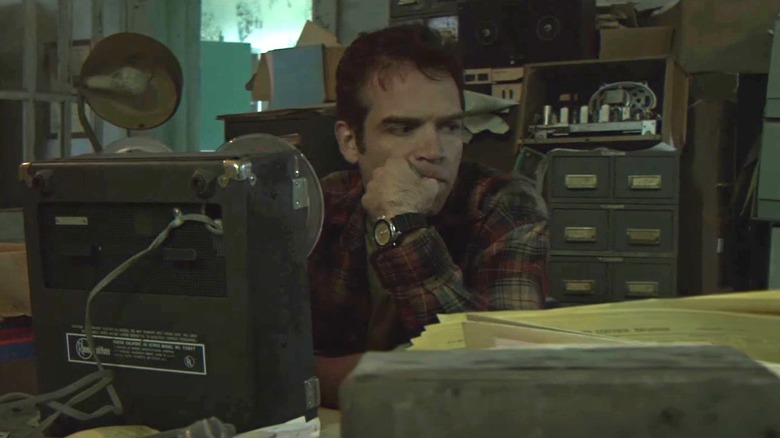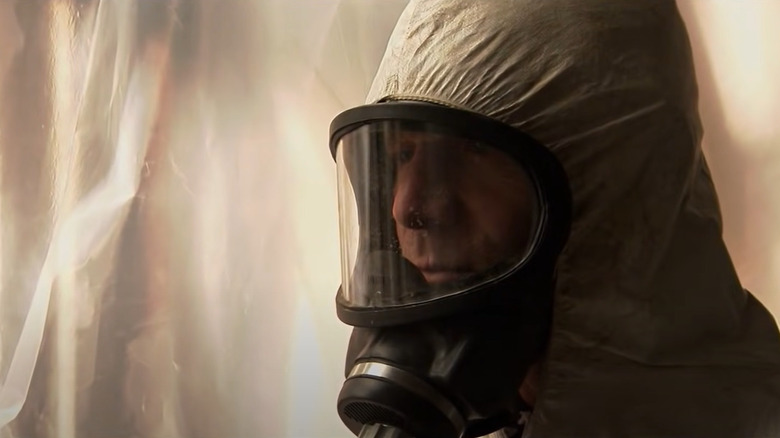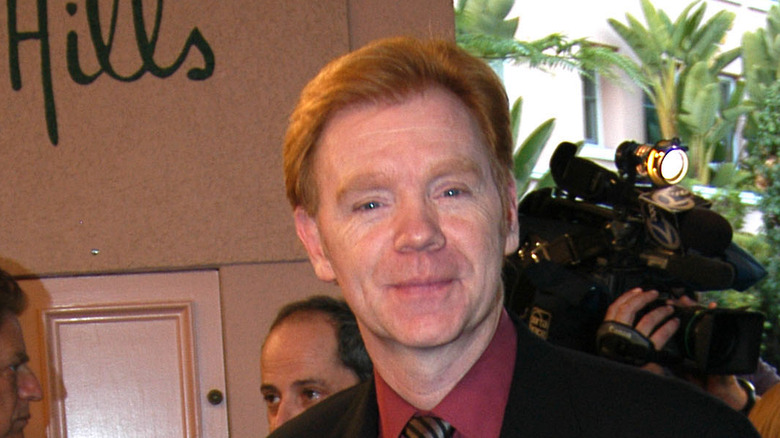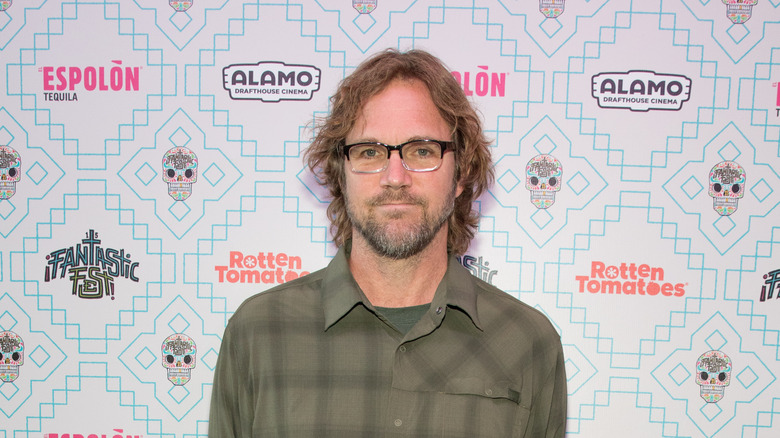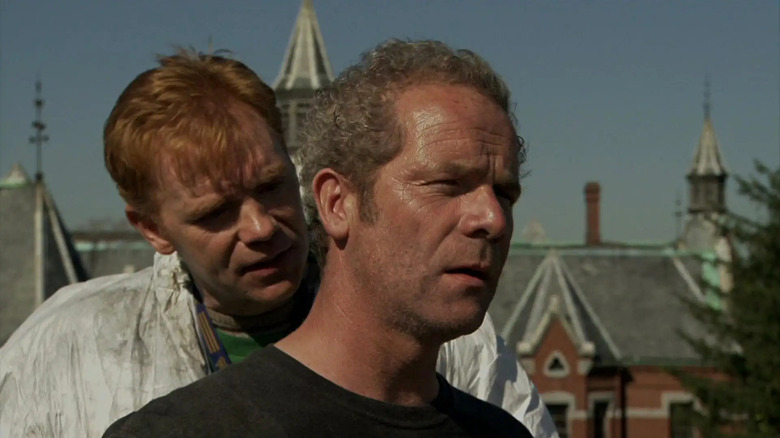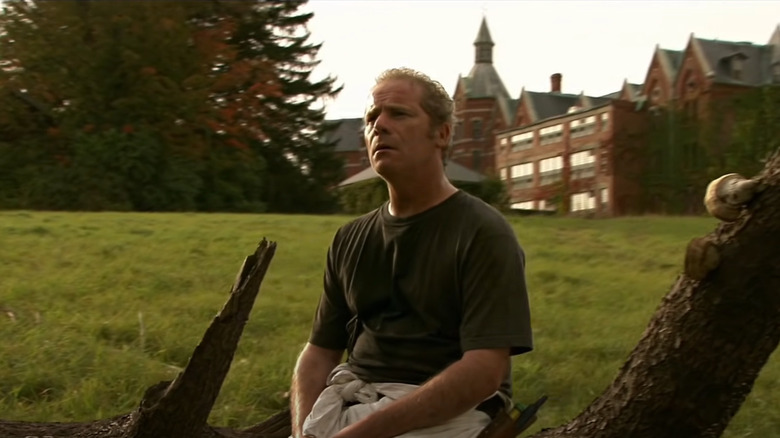The Ending Of Session 9 Explained
"Session 9" is a horror film that went largely unnoticed at the time of its release back in 2001, but has since gained more attention among fans of the genre. Directed by Brad Anderson, who may be best known to most audiences for the Christian Bale-led film "The Machinist." Like that film, "Session 9" similarly explores themes of psychological terror and a warped reality.
At the beginning of the film, we're introduced to a motley crew of tradesmen named Phil (David Caruso), Hank (Josh Lucas), Jeff (Brendan Sexton III), and Mike (Stephen Gevedon), who all work for their small company's owner, Gordon Fleming (Peter Mullan). Specializing in the removal of asbestos from properties, they take on a highly lucrative but time-sensitive job with a one-week deadline at the site of the former Danvers State Mental Hospital in Massachusetts, which now lies derelict. But as the crew begins their work, they soon realize that — though the facility is abandoned and its staff and patients long gone — the evidence of their time there remains, as does the dark history that still hangs over the building.
"Session 9" comes to a close with a dramatic twist ending that leaves just as many questions as it does answers. With that in mind, let's take a look back at the ending of "Session 9" and what it all means.
What you need to remember about the plot of Session 9
While combing through the labyrinthian hospital, Mike finds a doctor's office filled with hundreds of sensitive files. When curiosity gets the better of him, he listens to the audio recordings of sessions with Mary Hobbes, a former patient who suffered from dissociative identity disorder. Throughout the film, excerpts of these sessions are played, shedding light on the now-deceased patient's trauma and revealing a number of her alternative personalities.
As work on the site continues, a series of strange events plague the other members of the crew. Hank disappears entirely with no one knowing where he went, resulting in a replacement being brought in. Mike becomes withdrawn as he grows more and more obsessed with Mary Hobbes' tapes, and Gordon — troubled by hearing a voice calling to him at Danvers — begins to crack which leads to troubles at home.
With the situation becoming more dire and the crew's looming deadline getting closer, tensions flare among them. Phil loses faith in Gordon's leadership after he reveals he hit his wife at home one night, leading Phil to suggest that he should take over the job to Mike. Then, Jeff claims to have spotted Hank, so the crew split up to try and find him.
What happens at the end of Session 9?
By the end of the film, what should have been a simple asbestos removal job has ended in total disaster. Nearly every member of the crew has seemingly gone missing, with Gordon the only one still wandering the halls of the facility. It's then that he's met by Hank's replacement, Craig (Larry Fessenden), who's shocked to find the site in a state of chaos with Hank lying wounded on the floor and Gordon standing over him, delirious, and the truth of what really happened over the past week is finally revealed.
In a conversation between Phil and Gordon — where the latter seemingly figures out that Phil was responsible for attacking Hank — he's told that he needs to wake up. As Gordon looks back, trying to recall his deeply repressed memories of what happened, Phil vanishes into thin air and Gordon finally realizes that he was the one responsible for the crew's deaths. Waiting to strike until they were alone, Gordon took them out one by one until he was the last one alive.
After finally waking up and seeing reality as it is, in the final shot of the film, we watch Gordon breaking down on his cell phone, and begging his wife for forgiveness. As for Hank's death, and to figure out what drove Gordon to begin his killing spree, there's still plenty more to explain.
Where did Hank go?
Partway through the film, while working solo in a remote section of the hospital, Hank discovers a small fortune in silver coins peeking out through the wall. Among the coins are a number of other valuable personal artifacts, such as gold teeth, rings, and even a lobotomy pick. But unbeknownst to Hank, and in a grim reveal that only we see, he's actually looting one side of the facility's crematorium where former patients were incinerated after their departure.
With no way to smuggle the valuables out in front of the others, and determined to keep the stash for himself, he returns under cover of darkness to collect it all. On his way out, however, Hank crosses paths with a mysterious figure, with the revelation following that he never arrived at the job site the next morning. While trying to locate him, the crew calls Hank's girlfriend, who leads us to believe he's ditched Gordon and the rest of his coworkers and is flying out to Miami. Of course, as we soon find out, Hank never even left the hospital grounds.
In reality, the mysterious figure he was accosted by was Gordon, who, with a newfound knowledge of how to perform a lobotomy, makes Hank the first victim we know of. It's why when Hank reemerges later that week, he's only able to repeat his final words to Gordon, asking "Why are you here?" It also explains why he's wearing sunglasses, which is to cover up the black eye left on a patient after a lobotomy.
Who was Mary Hobbes?
Patient #444 at the Danvers State Mental Hospital when it was still active, Mary Hobbes was admitted at a young age in the wake of a family tragedy that remains unspecified throughout most of the film. Upon admission to the hospital, she was diagnosed with dissociative identity disorder, with a trio of personalities separate from her own known as "alternates." Attempts by doctors to treat her were recorded on a number of tapes labeled sessions one through nine, which Mike discovers.
A former law student with a keen knowledge of criminal history, Mike is immediately drawn to the disturbing file. Over time, we find out that whatever happened to Mary occurred over Christmas, 22 years before the sessions were recorded, and in the city of Lowell, Massachusetts. Mike further deduces through the recordings that each of Mary's alternates "live" in a different part of her. "The Princess" lives in the tongue, and talks the most. "Billy" lives in the eyes, as he sees everything.
The doctors are less interested in those two, however, as they prove less than helpful in helping Mary recall what happened that night. Instead, only a third alternate known as "Simon" seems to know what happened, but waking him is easier said than done. Finally, in the ninth and final session, the doctor interviewing Mary and her alternates gets his wish, and the voice of Simon is finally revealed.
What really happened at Gordon's house?
Throughout "Session 9," the audience is repeatedly shown a scene of Gordon parked outside his family's home, watching his wife Wendy (Linda Carmichael) and infant daughter from his car before opening the door and heading inside. As the film progresses, a brief line of dialogue is added, before being violently cut with a scream, suggesting some tragic incident playing out. Gordon later confesses to Phil that the night they won the job contract, he came home to celebrate with his wife, only to have snapped and hit her after she spilled a pot of boiling water on him. But, like much of "Session 9," what we're seen and told isn't the whole truth.
In reality, that fateful night at Gordon's home ended in a much more violent way, with Gordon lashing out and murdering his wife and daughter in an unexpected act of violence. There are even a number of clues that heavily foreshadow their deaths, with everything from dried blood being shown on Gordon's hands, the flowers he purchased for her found discarded in the hospital, and even a slow pan to Mary Hobbes' grave whilst Gordon is supposedly on the phone with Wendy in the cemetery. Who he was really talking to is unknown, as in reality he may have truly believed he was talking to Wendy, or perhaps instead the voice of Simon.
Who or what was Simon?
Who or what Simon is remains one of the film's most interesting questions. Revealed to doctors during Mary's ninth psychiatric session, Simon is believed to be the only one of her alternates who is truly malevolent. During the session, Simon recalls what happened that Christmas night in Lowell, stating that Mary was startled by her brother Peter, causing her to be badly wounded and fall onto her doll. It was then that the presence of Simon took over, leading her to retaliate and murder not just her brother, but her parents as well.
Beyond the influence that Simon had on Mary ever since that night in Lowell (or perhaps even earlier), it's shown that the alternate has the ability to reach out to others. While touring the property, it first speaks to Gordon as he's staring down a long corridor. Just hours later, he perpetrates the grisly murder at home that's subsequently buried deep in his subconscious.
One way of interpreting Simon is to view it as a literal entity, which possessed both Gordon and Mary during a moment of weakness and caused them to lash out violently. Another interpretation instead views Simon as simply a manifestation of our darkest urges, which only come to light when we're pushed to a breaking point — as both Gordon and Mary were. The final line of the film, in which Simon tells doctors that it "lives in the weak and the wounded" can support both theories, implying that it can only take a new host who is vulnerable, or is instead a mentality that thrives in the mentally broken.
Other theories about the ending
At its heart, "Session 9" is a story of the plight of blue-collar workers and one man among them being pushed to his breaking point, as well as the destructive aftermath it has on his life. Part of what's made the budget horror film such an enduring favorite among audiences over 20 years after its release is the elements left open to interpretation. While we've already explored who or what Simon was, and the truth of what happened at Gordon's home, there are still some bits of the story that are worth exploring.
In a post in the r/horror subreddit, a user presented a particularly interesting theory that claimed Gordon was actually a patient at the hospital, either in the present day or years prior. The theory goes on to say that everything we saw was inside of Gordon's head and that Phil, Hank, and the rest of the crew were all figments of his imagination, and even competing alternates much like Mary's. There is a fair bit of evidence to support the belief that the first time we see Gordon entering Danvers State may not truly be his first, such as his ability to seemingly find his way around the sprawling building with ease, and later his collection of family photos arranged in Mary's former room.
Though it might be a bit of a stretch, given that there are arguably more straightforward explanations for each point, it's an example of how much "Session 9" leaves its audience thinking long after the credits roll.
What has the cast said about Session 9?
Passionate and curious fans aren't the only ones who have talked at length about the niche horror favorite. David Caruso, who plays Phil, appeared in an interview back in 2001 alongside director Brad Anderson with AboutFilm.com, and opened up about what it was like to work on the set of "Session 9," saying: "Danvers is not a movie location. It really is [a mental hospital]. It was a place we never got comfortable in ... It was always scary, and you could really feel the pain of the people that were at Danvers." He went on to talk more about the location, and revealed that one of the film's crucial plot elements was rooted in reality: "there's a lot of stuff lying around that you can take a look at should you choose to. There are a lot of case folders and stuff. Every once in a while you would maybe look through a real case folder."
20 years later, fellow cast member Stephen Gevedon, who played Mike, spoke to Fangoria where he added to how unsettling just being on the then-condemned property really was, saying, "You wouldn't want to go there at night, man. Like, that would be too much, even for me."
What has director Brad Anderson said about Session 9?
Alongside Stephen Gevedon in the interview with Fangoria, director Brad Anderson opened up about the true crime case that inspired the story of "Session 9," and also what prompted him to choose Danvers as the film's location. Citing the Richard Rosenthal murders – in which an office worker brutally murdered his wife and child over an argument over dinner — the director stated, "The guy was pretty normal – educated, y'know? Wasn't known to have any mental issues. But something snapped. He snapped. And the thing that was to me creepy about it – beyond the horrific, outrageous nature of the crime – was that he just went about his daily routine for a number of days afterward."
Speaking further about settling on a location for the film, the director said, "I lived in Boston for a number of years, and I would drive by Danvers all the time. When Steve [Gevedon] and I were first brainstorming, we didn't have the framework of what we wanted to hang our horror film on. But then I remembered Danvers, and we thought it'd be cool to set a story [there]."
What have critics said about session 9?
Though "Session 9" only grossed $1.6 million at the global box office upon release, it still managed to attract a considerable amount of attention from critics, with the general consensus being largely positive. Critics like Peter Travers of Rolling Stone praised "Session 9" as "a spine-tingler directed with fierce finesse." Others, such as Owen Gleiberman of Entertainment Weekly, went into a bit more detail, calling the film "a marvel of vérité nightmare atmosphere." He went on to say, "At moments, you can just about smell the invisible fibers, and the ghosts of former patients as well."
Of course, not all critics were as enthralled with Brad Anderson's movie. Most took issue with the number of plot threads presented, such as Robert Koehler of Variety, who criticized the movie as, "little more than an overworked exercise in jostling red herrings." Ultimately, "Session 9" proved to be a divisive entry among horror films, but one that still manages to captivate audiences both then and now.
Will we ever see more entries in the story?
Though it leaves some of its most pressing questions open to interpretation by audiences, "Session 9" does end with a satisfying conclusion that leaves little room for a sequel. Of course, the sky's the limit should the team behind the horror flick ever want to make a prequel, which is exactly what director Brad Anderson had in mind years ago. The director revealed some details to Fangoria, saying, "The general gist of the story was that it'd be about Mary Hobbes, the character in the original movie who's on the tapes and who has these alternate personalities and who would ultimately realize she killed her family on Christmas Day. Here we'd learn the entire Mary Hobbes story – how she went from being a fairly normal 12-year-old girl in 1959 and '58 to slaughtering her whole family, and why."
Unfortunately, problems quickly arose regarding the prospect of a potential prequel, thanks to an unusual company rule by the current holder of the film's legal rights. Anderson explained, "The problem is, we then went to Focus and said, 'We want to do this movie, and it's a prequel to 'Session 9.' It's one of your movies, if you even know about it.' And they were like, 'Oh.' Next thing you know we get the calls from the lawyer saying, 'Well, you can't do that. We own that property, and we don't normally allow filmmakers to make sequels or prequels to our movies.'" Whether these issues could be overcome for a future prequel or sequel remains to be seen, or indeed if there is still much interest in a follow-up so long after the original.
